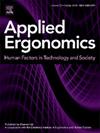基于模拟的被动背部支撑外骨骼的生物力学评估:在持续向前弯曲任务中各种支持水平的比较
IF 3.4
2区 工程技术
Q2 ENGINEERING, INDUSTRIAL
引用次数: 0
摘要
本研究通过肌肉骨骼模拟评估了被动式背支撑外骨骼(BSE)的五种支撑水平(40%、55%、70%、85%和100%致动器强度)对商业蟹分选相关生物力学载荷的影响。收集了20名男性参与者进行模拟螃蟹分拣的全身运动学数据,并将其整合到人-疯牛病交互模拟框架中,以预测人-疯牛病界面处的肌肉活动、脊柱负荷和接触力。增加BSE支持水平通常会降低躯干伸肌活动(高达28.6%)和腰骶反作用力(高达30.7%)。然而,减少的生物力学负荷是以增加胸部和大腿区域的接触力为代价的,这可能会给脆弱的使用者带来局部不适。这些发现表明,虽然BSEs可以有效地减少螃蟹分拣过程中腰背部的生物力学负荷,但应该仔细选择支撑水平,以确保足够的帮助,同时最大限度地减少潜在的副作用,如局部不适或疼痛。本文章由计算机程序翻译,如有差异,请以英文原文为准。
Simulation-based biomechanical assessment of a passive back support exoskeleton: Comparison of various support levels during a sustained forward bending task
This study evaluated the impacts of five support levels (40, 55, 70, 85, and 100 % actuator strengths) of a passive back-support exoskeleton (BSE) on biomechanical loads associated with commercial crab sorting through musculoskeletal simulation. Whole-body kinematics of 20 male participants performing simulated crab sorting were collected and integrated into a human-BSE interaction simulation framework to predict muscle activity, spinal loads, and contact forces at the human-BSE interfaces. Increasing the BSE support level generally reduced trunk extensor muscle activity (up to 28.6 %) and lumbosacral reaction forces (up to 30.7 %). However, the reduced biomechanical load came at the expense of increased contact forces on the chest and thigh areas, potentially causing local discomfort for vulnerable users. These findings suggest that while BSEs can be effective in reducing low back biomechanical loads during crab sorting, support levels should be carefully selected to ensure adequate assistance while minimizing potential side effects, such as local discomfort or pain.
求助全文
通过发布文献求助,成功后即可免费获取论文全文。
去求助
来源期刊

Applied Ergonomics
工程技术-工程:工业
CiteScore
7.50
自引率
9.40%
发文量
248
审稿时长
53 days
期刊介绍:
Applied Ergonomics is aimed at ergonomists and all those interested in applying ergonomics/human factors in the design, planning and management of technical and social systems at work or leisure. Readership is truly international with subscribers in over 50 countries. Professionals for whom Applied Ergonomics is of interest include: ergonomists, designers, industrial engineers, health and safety specialists, systems engineers, design engineers, organizational psychologists, occupational health specialists and human-computer interaction specialists.
 求助内容:
求助内容: 应助结果提醒方式:
应助结果提醒方式:


